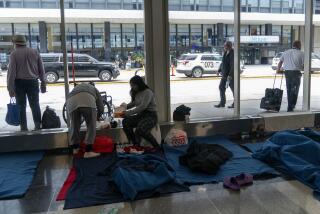Chicago Wrestles With Crowded Airports, Struggles to Get New Facility Off Ground
- Share via
CHICAGO — Mike Milbratz just wants to get home--on time. But there’s a 7,700-acre obstacle in his way: O’Hare International Airport.
If it’s an average day at the world’s busiest airport, Milbratz will be about 10 minutes late.
Milbratz, a businessman who flies more than 50,000 miles annually, recounted his latest arrival at O’Hare: “Driving out on the tollway, you could look into the sky and see the airplanes lined up like fireflies.”
About 5% of the 811,000 flights that passed through O’Hare in 1990 were behind schedule. The Federal Aviation Administration says the number of passengers flying through O’Hare is likely to jump from about 315 million last year to 420 million by the end of the decade.
A commission representing Chicago, Illinois and Indiana will decide by early next year if, and where, a new regional airport should be built. Secretary of Transportation Secretary Samuel K. Skinner, who has ultimate authority over the site, has said the commission’s decision will stand.
There are problems with all of the proposed sites: Gary, Ind., and Lake Calumet on Chicago’s southeast side; and rural sites farther south in Peotone, Kankakee and straddling the Illinois-Indiana line near Beecher, Ill.
Supporters of Gary and Lake Calumet say their locations, the closest to downtown Chicago, would attract more passengers and bring jobs to areas still suffering from the decline of the steel industry.
But the urban sites would displace more people and businesses and cost more to complete.
The Lake Calumet site would cost $17.4 billion, said the commission’s consulting firm, TAMS Consultants Inc. Airports in Peotone, Kankakee or Beecher likely could be built for a fraction of that. But some say those sites are simply too far away, with taxi fare from the farthest proposed site in Kankakee, about 50 miles away, estimated at $100.
A new airport is at least 10 years off as congestion clogs O’Hare and Midway Airport on the city’s southwest side.
“We’re at absolutely full capacity at O’Hare and almost full capacity at Midway,” Skinner said. “Airlines can’t expand; the demand for service is not being met. Business and people are bypassing Chicago for location or relocation because they know the air system is crowded.”
Busy flight patterns raise another concern: safety.
“If traffic increases . . . there is more opportunity for a mistake,” FAA spokesman Jim Dermody said.
New runways at O’Hare are favored as a short-term answer by Skinner and some businesses, which fear losing some of the $11 billion the airport pumps into the region’s economy each year. But a consent decree between the city, which owns O’Hare, and expansion opponents forbids operation of new runways until 1995.
The O’Hare Citizens Coalition favors a ban on new runways at O’Hare, a cutback of flights from last year’s 811,000 departures and arrivals to 700,000, a phase-out of older and noisier jets by 1996 and a new airport at a rural site.
More to Read
Sign up for Essential California
The most important California stories and recommendations in your inbox every morning.
You may occasionally receive promotional content from the Los Angeles Times.









